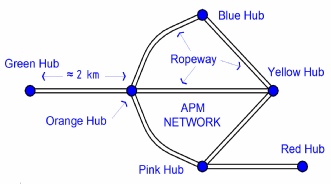The APM is simply a grouping of hubs that are designed to serve as collection points for passengers. For the APM to achieve maximum benefits, the hub must be within reasonable walking distance for most people. There should be no need for additional surface transportation and vehicle storage.
The initial network layout is critical to the success of the APM. Theoretically, hubs are placed in the shape of interconnected equilateral triangles. Dead end links would be avoided but mid-
South American cities with large long straight boulevards with center landscape dividers can provide an opportunity to overlay the existing transportation links. Because of the small terminal size, it is possible to place terminals within existing large round-
 Selecting the correct location for the hubs can be highly controversial because of the potential for great profits from land development. The increase in value of land surrounding the hubs is the driving economic force that makes the APM financially profitable. A multi story structure above the hub is valuable real estate for retail, offices and residential development. The proximity to immediate access to daily urban transport that is independent of weather or road congestion is valuable.Once the hub locations and link corridors are selected it is difficult to make changes unless anticipated in the initial planning process. Certain initial parameters, such as the direction of carrier flow in the terminals and carrier dimensions are fixed. However, if the initial layout provides walking access to a hub, there may be less need for any additional hub.
Selecting the correct location for the hubs can be highly controversial because of the potential for great profits from land development. The increase in value of land surrounding the hubs is the driving economic force that makes the APM financially profitable. A multi story structure above the hub is valuable real estate for retail, offices and residential development. The proximity to immediate access to daily urban transport that is independent of weather or road congestion is valuable.Once the hub locations and link corridors are selected it is difficult to make changes unless anticipated in the initial planning process. Certain initial parameters, such as the direction of carrier flow in the terminals and carrier dimensions are fixed. However, if the initial layout provides walking access to a hub, there may be less need for any additional hub.
Network Design